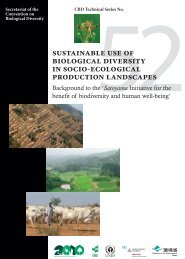INDIAN SCIENCE CONGRESS - India Environment Portal
INDIAN SCIENCE CONGRESS - India Environment Portal
INDIAN SCIENCE CONGRESS - India Environment Portal
You also want an ePaper? Increase the reach of your titles
YUMPU automatically turns print PDFs into web optimized ePapers that Google loves.
30<br />
Proc. 98th <strong>India</strong>n Science Congress, Part II : Abstracts of Symposium/Invited Lecture<br />
Keywords : Lentinus, nutrition, nutraceutical, mushrooms<br />
Genus Lentinus is widely appreciated for its culinary and neutraceutical<br />
attributes. Presently five wild species of this genus, namely Lentinus sajor-caju,<br />
L. connatus, L. torulosus, L. cladopus and L. squarrosulus were selected for<br />
evaluating the nutritional and nutraceutical components. These were collected from<br />
different hosts in different seasons and from different altitudes ranging from 200 m<br />
to 2,100 m in North West <strong>India</strong>. Among the nutritional components- total protein by<br />
Kjeldhal method, crude fibers by digestion with acid and base, crude fat through<br />
soxhlet apparatus and carbohydrates from the difference between total constituents<br />
and minerals through atomic absorption spectrophotometer. As the protective role<br />
of sugars for cell healing these have been characterized by HPLC. Investigations<br />
were conducted on samples taken from dried fruit bodies. Out of all the samples<br />
examined for nutritional components, maximum amount of protein (2. 450 %) was<br />
recorded in L. torulosus and lowest contents were found in L. connatus (0. 525<br />
%). L. sajor-caju and Lentinus cladopus showed highest percentage of crude fat<br />
(0. 80 %) while other three contain considerably low percentage of crude fat. Total<br />
crude fibres were found in high quantity in L. sajor-caju (3. 99 %) and minimum<br />
percentage was observed in L. squarrosulus (1. 83 %). Ash contents were found<br />
maximum in L. squarrosulus (2. 21 %) and minimum were observed in L.<br />
torulosus (1. 52 %). The carbohydrate percentage was found to be maximum in<br />
L. cladopus (89. 10 %) and minimum in L. sajor-caju (85. 82 %) the other three<br />
species contain good amount of carbohydrates. Although the samples were dried<br />
at 45 ºC, the samples still contained moisture. The rest of the part is constituted by<br />
moisture. Minerals were estimated in mg/100 gm of the dried sample. Out of all the<br />
samples examined, maximum amount of Ca (221. 3 mg) was recorded in L.<br />
connatus followed by L. sajor-caju (97. 3 mg). The other species contained very<br />
low Ca. Mg recorded maximum levels in L. connatus (1,722 mg) followed by L.<br />
cladopus (1,260 mg). The other three species also possesses significant levels of<br />
this mineral with L. torulosus having minimum quantity (807 mg). Maximum<br />
amount of copper (3. 33 mg) was recorded in L. cladopus followed by 2. 33 mg<br />
in L. torulosus where as minimum quantity of this mineral (0. 75 mg) was recorded<br />
in L. squarrosulus. Zn was maximum (6. 10 mg) in L. squarrosulus followed by<br />
4. 0 mg in both L. cladopus and L. sajor-caju whereas minimum quantity (3. 0<br />
mg) of Zn was recorded in L. connatus. Maximum amount of Fe (37. 0 mg) was<br />
recorded in L. cladopus followed by 18. 66 mg in L. connatus whereas minimum
















